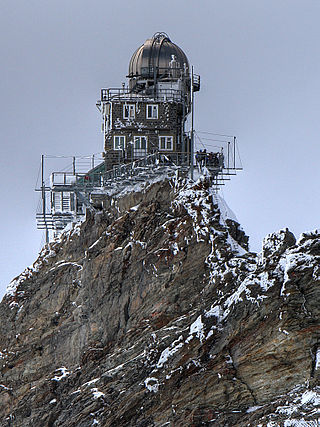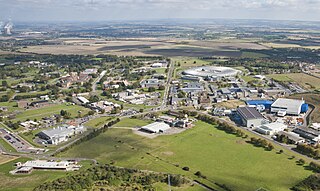
An observatory is a location used for observing terrestrial, marine, or celestial events. Astronomy, climatology/meteorology, geophysics, oceanography and volcanology are examples of disciplines for which observatories have been constructed.

The Solar and Heliospheric Observatory (SOHO) is a European Space Agency (ESA) spacecraft built by a European industrial consortium led by Matra Marconi Space that was launched on a Lockheed Martin Atlas IIAS launch vehicle on 2 December 1995, to study the Sun. It has also discovered over 5,000 comets. It began normal operations in May 1996. It is a joint project between the European Space Agency (ESA) and NASA. SOHO was part of the International Solar Terrestrial Physics Program (ISTP). Originally planned as a two-year mission, SOHO continues to operate after over 25 years in space; the mission has been extended until the end of 2025, subject to review and confirmation by ESA's Science Programme Committee.

Astrophysics is a science that employs the methods and principles of physics and chemistry in the study of astronomical objects and phenomena. As one of the founders of the discipline, James Keeler, said, astrophysics "seeks to ascertain the nature of the heavenly bodies, rather than their positions or motions in space–what they are, rather than where they are", which is studied in celestial mechanics.
The SAO/NASA Astrophysics Data System (ADS) is a digital library portal for researchers on astronomy and physics, operated for NASA by the Smithsonian Astrophysical Observatory. ADS maintains three bibliographic collections containing over 15 million records, including all arXiv e-prints. Abstracts and full-text of major astronomy and physics publications are indexed and searchable through the portal.

The Rutherford Appleton Laboratory (RAL) is one of the national scientific research laboratories in the UK operated by the Science and Technology Facilities Council (STFC). It began as the Rutherford High Energy Laboratory, merged with the Atlas Computer Laboratory in 1975 to create the Rutherford Lab; then in 1979 with the Appleton Laboratory to form the current laboratory.
The Millennium Run, or Millennium Simulation is a computer N-body simulation used to investigate how the distribution of matter in the Universe has evolved over time, in particular, how the observed population of galaxies was formed. It is used by scientists working in physical cosmology to compare observations with theoretical predictions.

The Indian Institute of Astrophysics (IIA), with its headquarters in Bengaluru, is an autonomous research institute wholly funded by the Department of Science and Technology, Government of India. IIA conducts research primarily in the areas of astronomy, astrophysics and related fields.
Solar physics is the branch of astrophysics that specializes in the study of the Sun. It intersects with many disciplines of pure physics and astrophysics.

The Astronomical Observatory of Modra, also known as Modra Observatory or the Astronomical and Geophysical observatory in Modra, is an astronomical observatory located in Modra, Slovakia. It is owned and operated by the Comenius University in Bratislava. The scientific research at the observatory is led by the Department of Astronomy, Physics of the Earth and Meteorology, Faculty of Mathematics, Physics and Informatics.

The Astronomical Observatory of Rome is one of twelve Astronomical Observatories in Italy. The main site of the Observatory is Monte Porzio Catone. Part of the Istituto Nazionale di Astrofisica since 2002.
The UCL Mullard Space Science Laboratory (MSSL) is the United Kingdom's largest university space research group. MSSL is part of the Department of Space and Climate Physics at University College London (UCL), one of the first universities in the world to conduct space research. Since its establishment, MSSL has participated in 35 satellite missions, 10 of which are currently in operation, and in over 200 sounding rocket experiments.
The Astrophysical Virtual Observatory (AVO) project conducted a research and demonstration programme on the scientific requirements and technologies necessary to build a virtual observatory for European astronomy. The AVO has been jointly funded by the European Commission with six European organisations participating in a three-year Phase-A work programme, valued at 5 million euro. The partner organisations were the European Southern Observatory (ESO) in Munich, Germany, the European Space Agency (ESA), AstroGrid, the CNRS-supported Centre de Données Astronomiques de Strasbourg (CDS), the University Louis Pasteur in Strasbourg, France, the CNRS-supported TERAPIX astronomical data centre at the Institut d'Astrophysique in Paris, France, and the Jodrell Bank Observatory of the Victoria University of Manchester, United Kingdom.
The International Virtual Observatory Alliance (IVOA) is a worldwide scientific organisation formed in June 2002. Its mission is to facilitate international coordination and collaboration necessary for enabling global and integrated access to data gathered by astronomical observatories. An information system allowing such an access is called a virtual observatory. The main task of the organisation so far has focused on defining standards to ensure interoperability of the different virtual observatory projects already existing or in development.
The US National Virtual Observatory'-NVO- was conceived to allow scientists to access data from multiple astronomical observatories, including ground and space-based facilities, through a single portal. Originally, the National Science Foundation (NSF) funded the information technology research that created the basic NVO infrastructure through a multi-organization collaborative effort. The NVO was more than a “digital library”; it was a vibrant, growing online research facility akin to a bricks-and-mortar observatory for professional astronomers.
The D-Grid Initiative was a government project to fund computer infrastructure for education and research (e-Science) in Germany. It uses the term grid computing. D-Grid started September 1, 2005 with six community projects and an integration project (DGI) as well as several partner projects.

The Murchison Widefield Array (MWA) is a joint project between an international consortium of organisations to construct and operate a low-frequency radio array. 'Widefield' refers to its very large field of view. Operating in the frequency range 70–300 MHz, the main scientific goals of the MWA are to detect neutral atomic Hydrogen emission from the cosmological Epoch of Reionization (EoR), to study the Sun, the heliosphere, the Earth's ionosphere, and radio transient phenomena, as well as map the extragalactic radio sky. It is located at the Murchison Radio-astronomy Observatory (MRO).
The High Altitude Observatory (HAO) is a laboratory of the US National Center for Atmospheric Research (NCAR). HAO operates the Mauna Loa Solar Observatory on Hawaii and a research institute in Boulder, Colorado.

Leibniz Institute for Astrophysics Potsdam (AIP) is a German research institute. It is the successor of the Berlin Observatory founded in 1700 and of the Astrophysical Observatory Potsdam (AOP) founded in 1874. The latter was the world's first observatory to emphasize explicitly the research area of astrophysics. The AIP was founded in 1992, in a re-structuring following the German reunification.

Astropy is a collection of software packages written in the Python programming language and designed for use in astronomy. The software is a single, free, core package for astronomical utilities due to the increasingly widespread usage of Python by astronomers, and to foster interoperability between various extant Python astronomy packages. Astropy is included in several large Python distributions; it is part of package managers for Linux and macOS, the Anaconda Python Distribution, Enthought Canopy and Ureka.









